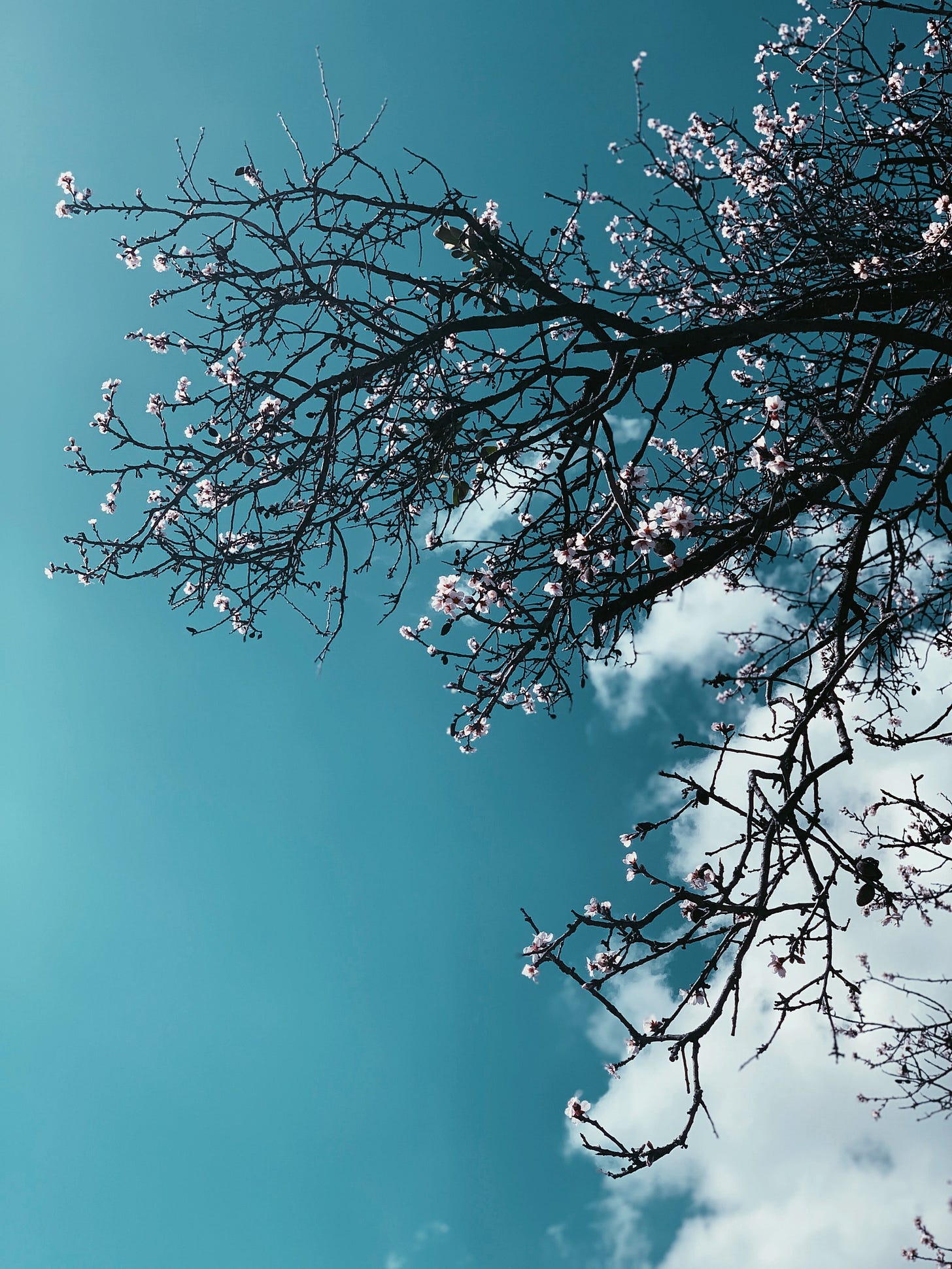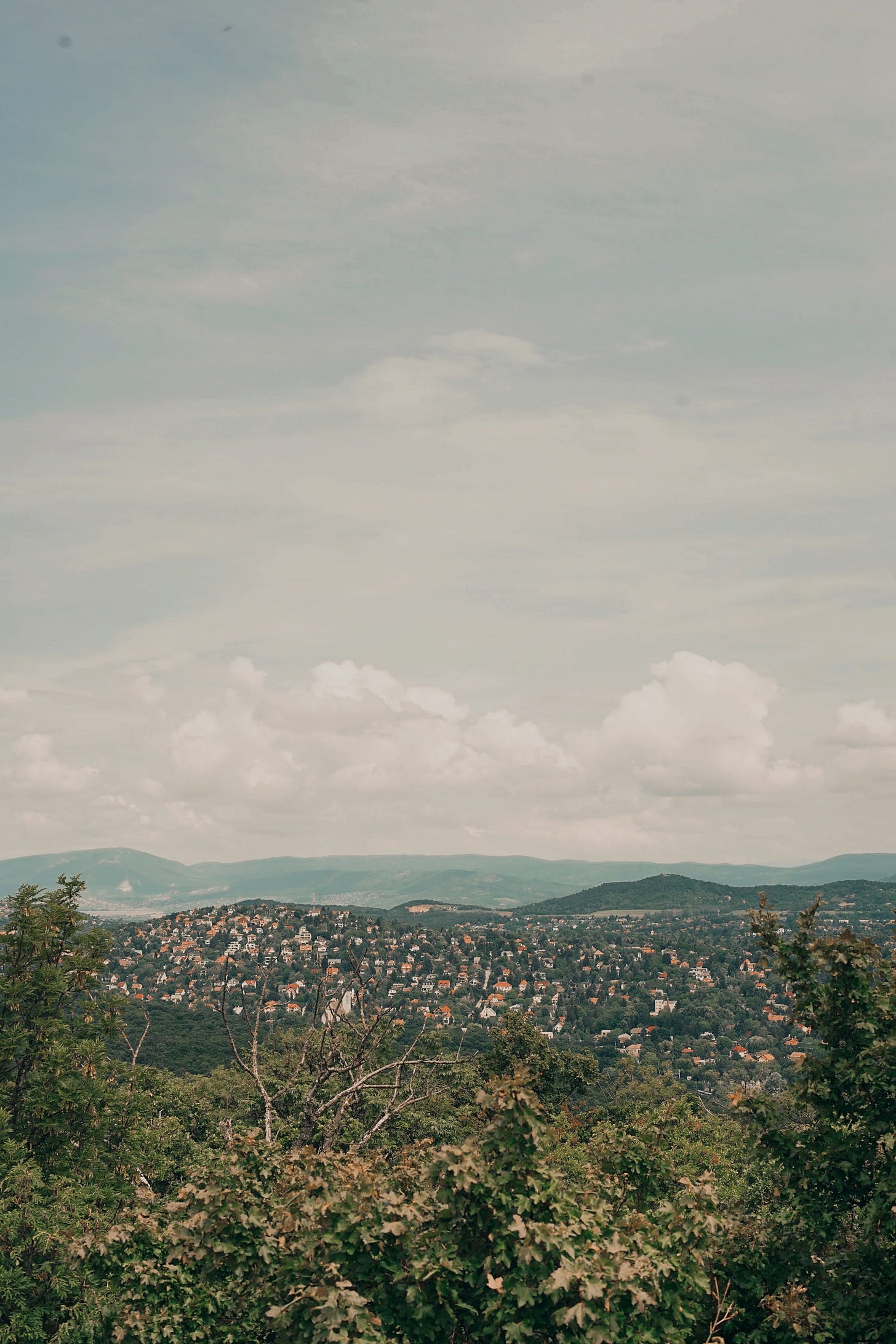“Look carefully around, take in the grasses, the trees below, the stones at our feet, the flowers, the ringing bells of the cows. Since we sat down on this bench, the world has ever so slightly changed; it can never go back.”
(Carl Gustav Jung to Marie-Louise von Franz)
what do you think, gentle reader, how and when do new experiences get old? especially the ones we mark as ‘significant’. how long until contrasting and comparing quarantine coping mechanisms becomes a trite trope? how long until the spring of 2020 ends up in an instagrammified narrative—on one side the inevitably under-appreciated heroism of frontline workers, on the other the claustrophobic, yet cherished life under lockdown. seals sunbathing on the bank of the Elbe, dolphins in Venice, tame singing birds in European suburbs, the entire Disney fantasy of Earth suddenly recovering and welcoming a magical new life (post-capitalist, inclusive, sustainable, non-violent, aesthetically pleasing by nature).

an almond tree in bloom, Antónia lépcső, March 2020
one of these days i would love to see a colorful infographic emerge in a digital newspaper engaged in explanatory journalism, ranking privileged quarantine activities by popularity: it would list everything from baking bread from scratch to potting succulents, embarking on a ‘fitness journey’, learning macramé, daydrinking, taking MOOCs, renovating, building a cabin, decluttering, learning how to frost a cake, running marathons in the backyard, participating in a plank challenge, participating in a book club, going on zoom dates with strangers. the pastel-painted ode to holy self-care. as if it was all over, as if we could return to the old ways.

grey was the sky at sunrise over Óbuda and Pest, as seen from the slope of József-hegy, June 2020
there is a healthy dose of self-deprecation in this diatribe, mind you. i am painfully aware of my own privilege and a certain tendency to create my own zauberbergesque narrative of these past months. whereas, upon my arrival in Budapest i was just bitter and jaded.
said arrival was as unspectacular as it gets: taking off under a hopelessly grey sky, some 30 passengers on a cold airplane, landing under another hopelessly grey sky, and wheeling my luggage to a café to treat myself to a customary “ground control to Major Tom” coffee. a week later the government of Hungary declares state of emergency and announces lockdown.
the boys in parliament are in their element: they’ve got to play war against a new invisible enemy, they can be heroes. and i am handed a lopsided gift. metaphorically, it’s a seemingly empty box. in reality it’s 20 boxes in my childhood bedroom, containing the remnants of all my previous lives. as the contents of the moving boxes vanish (again with the selling or giving away of my belongings, i know), my new favorite toy, the seemingly empty, metaphorical box starts to make more sense. for the first time in years, i’ve been given time. time to fill this box with whatever i fancy. and in a peripatetic process, i choose to lay the stencil of slow thought upon my walks through the hilly Buda side of the Danube and see whether any pattern emerges.

porch of a Schwäbisch house built in 1840 on Svábhegy, June 2020
without the ususal distractions—noise, social life and familial obligations, deadlines, hangover—i begin to lead a double life. outwardly, i’m happily regressing into childhood, but in secret i spend long hours with scrutinizing my surroundings. this time, i truly want to see Buda as it is, pushing away the literary lens, the somewhat anachronistic yet nostalgia-laden attitude—i can’t play pretend living in 1932 anymore. and soon enough i realize that i still do, by building my Arcadia in my émigré sadness, in search of cosy security. i used to laugh at Márai’s émigré sadness, his neverending, dreamy quest for a long-lost city and its culture—i am not laughing anymore.
“The door was still there, but instead of the stairs, a pile of rubble rose toward the next level. Later I heard that this old Buda house had been hit by over thirty bombs, shells, and grenades. I knew some people who lived there—a seamstress who occasionally worked for me, a vet who looked after my dog, and, on the first floor, a retired high-court judge with his wife, with whom we sometimes had tea in Auguszt, the old Buda patisserie. Krisztinaváros, unlike the other Budapest districts, was always more like a small provincial Austrian town than a suburb. People spent years there in cosy security or moved there in search of cosy security.”
(Sándor Márai: Portraits of a Marriage)
Buda is many things Pest is not—this is one of the Great Dichotomies tormenting the collective Hungarian conscious: in a highly polarized society, every choice, conscious or unconsious can and will be invested with meaning and symbolism beyond rationality. these choices are initially handed down by family, often as a consequence of social traumata. hence, one simply cannot be neutral, centrist, or choose both or neither option. Buda or Pest? does it seem like an innocent question to you? does it boil down to a preference of green hills or big city life?

Buda castle as seen from the Chain Bridge on a windy day in May 2020
iconic 20th century modernist authors Géza Ottlik and Iván Mándy were best friends. Ottlik lived in Buda, often wrote about Buda, and despised filthy, chaotic, shady, liberal Pest, especially the notoriously multicultural 8th district, where Mándy lived at the time. in their old age he often called Mándy on the phone, and what began as a cordial chat ended in bitter fights. they argued and fought about anything and everything. anything and everything was meant to become a dichotomy-landmine in the vast minefield of Hungarian volksgeist. Ottlik loved tennis, Mándy loved football. Ottlik argued that football was for the uneducated masses. Mándy made scathing remarks about his friend’s undying love for Harris tweed, playing bridge or well, anything British. He also adored chaotic Pest where he spent his entire, magical childhood and shunned Ottlik for his stuffy, royalist, conservative tastes. “go to hell! go call your bourgie friends and pester them, not me,” Mándy would shout in his dry, high-pitched voice. “well, i’m done talking to you!” the next day Mándy would call Ottlik in an attempt to apologize, start a new conversation that would end all the same. they remained best friends until the last, apolitical insult parted them, but i am fairly certain if there’s a heaven they keep bickering there.

sunset over Tóth Árpád (Bástya) sétány after an exceptionally joyful day in June 2020
as the ancient capital of the (in our opinion) once glorious Kingdom of Hungary, Buda, strategically built on rolling hills overlooking the fords on the Danube saw dramatic changes throughout the centuries—at times overcrowded, a bustling capital of cultural exchange, at times almost completely deserted—but one thing remained constant for an awfully long time: Hungarians were in minority. Germans, Serbs, Ottoman Turks, Italians, Sefardi Jews used to populate the city within its walls and beyond. this was especially true once the settlements north and south of the capital began to grow and develop: the ancient Celtic-turned-Roman settlement of Aquincum/Óbuda and the Roman-turned-Hungarian village of Campona/Nagytétény, where multi-ethnicity was the norm until the late 17th century. and then, after the spectacular siege of Buda in 1686 and the end of Turkish rule, the city and its neighboring villages became almost entirely German-speaking. well, mostly Schwäbisch-speaking.
it took generations to somehow soften the German image, turn around the ethnic majority and create the catholic, conservative, Hungarian-speaking, somewhat backwards, sleepy and nostalgic image of Buda as 20th century literature and local patriots know it. however, this vision of Buda is highly selective. it comprises the 1st, 2nd, 12th districts, considering parts of the 11th and a handful streets in the 3rd, but anything beyond these imaginary borders is part of the other 99% of Hungary: the countryside.

view of Pesthidegkút, Máriaremete and the gliderport of Hármashatárhegy as seen from Kis-Sváb-hegy in June 2020
flânerie is impossible where layers of history are chipping, where signs and symbols abound. for years i used to look at architecture in this city with the intention of peeling back those layers of time, changes, and renovations—i wanted to know everything about every doorframe, every ornament, every tenant’s every story. signs and symbols cannot be made unseen; walks inteded to be romantic or leisurely are often disruptive in Buda. don’t walk with me. and if you do, just bear with me stopping at every stone. oh, look at that cross originally erected in 1690 in gratitude for a bountiful harvest! did you know that serviced apartments were a thing in Buda back in the 1930s and wealthy young men chose them as their hypermodern lodgings? that quasi-brutalist building next to the city archives they want to demolish—it’s several storeys deep and in order to enter, even the architects needed some sort of clearance, isn’t that cool? well, the interior design was outstanding, that’s even cooler. but it’s over now.

the modernist tower of the power control station in Buda Castle in April 2020. power obviously doesn’t need to be controlled anymore.
it’s over now, and it is a gradual realization, although after 4 months in my personal Arcadia of wilndernesses and modernist architecture intertwined, the sense of loss is acute: important landmarks are vanishing under the receding hairline of nearby forests, early modernism is generally misunderstood and renovated in bad taste, any other kind of modernism is shunned, remodeled, and a fictious past in a tourist-and-oligarch-friendly Castle is being built. the wealthy build their legacy at a furious speed: façadist villas and minimalist fortresses grow on the hills like mushrooms. this Buda, the real Buda now is vacuous, it’s sterile. the mysterious layers of history will be destroyed by those who lack an intimate knowledge of Harris tweed, bridge, silverware, and dignified defiance.

lovely early modernism in Napraforgó utca, Pasarét in April 2020
gosh, it seems like i’ve practically turned into Márai’s ghost! but i am at peace now, understanding that there is no cosy security, not here. this isn’t home anymore, and soon i’ll have to go. but before that, i’ll show you some more of Arcadia and end on a happier note.
until then, wishing you light steps,
n.



